The thought of a golf Club for the Neenah-Menasha area originated from a doctor, an ear, eye, nose and throat specialist by the name of Galford, who had recently moved to Neenah from Illinois. In 1926 Dr. Galford interested some of his new friends in the project. Some of those were John Studley, publisher of the Daily News-Times, Harold Hanson, Jos Weishaupt, manager of the Valley Inn, Bill Sawyer, J. Dudleigh Young, Gavin Young Jr., Gavin W. Young Sr., Ad. Henning, Ed. Saecker, Harold Landgraf, Wallace Brown, and others.
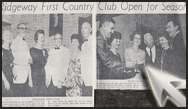 Writing this entirely from memory, it is impossible for me to mention all of the people involved, or to relate all the facts or incidents which occurred with 100% accuracy. I will cover the early years of Ridgeway Country Club beginning in 1926.
Writing this entirely from memory, it is impossible for me to mention all of the people involved, or to relate all the facts or incidents which occurred with 100% accuracy. I will cover the early years of Ridgeway Country Club beginning in 1926.
A sort of ad hoc committee was formed for the purpose of originating the club and securing members. Anyone who subscribed for a share of stock @ $100 would automatically become a member of the golf club. Dues were to be paid at the rate of $25 per year. The committee was quite successful in securing members. So, early in the membership drive, they obtained the services of a golf club architect from Milwaukee to assist in the selection of a site. About this time a committee from Butte des Morts Golf Club, then in its first or second year of play, approached our committee with the proposition that the organization be stopped, and all those who had signed would become members of Butte des Morts. This proposition was rejected and the committee continued with the organization.
The golf expert, after reviewing about five different sites, came up with the recommendation for the Prindle farm, saying there was adequate land (120 acres), a small pond, some wooded area, and gentle rolling land.
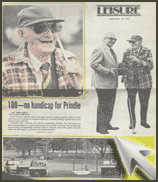 A committee of two, Harold Hanson and Dr. Galford, interviewed Mark Prindle and were successful in reaching an agreement for the purchase of the farm for the price of $25,000, with the condition that Mark could live in the house rent free, and that he would be employed in the maintenance of the course. Solicitation of members continued. Wally Brown, an architect with KC but residing in Oshkosh, drew a sketch of a clubhouse to be erected in the woods. This served as a very good sales pitch; for by the time the club opened it had secured 81 members from Oshkosh.
A committee of two, Harold Hanson and Dr. Galford, interviewed Mark Prindle and were successful in reaching an agreement for the purchase of the farm for the price of $25,000, with the condition that Mark could live in the house rent free, and that he would be employed in the maintenance of the course. Solicitation of members continued. Wally Brown, an architect with KC but residing in Oshkosh, drew a sketch of a clubhouse to be erected in the woods. This served as a very good sales pitch; for by the time the club opened it had secured 81 members from Oshkosh.
Construction of the course was started in 1927. Officers and directors had been elected. Gavin Young Sr. became the first president, and Ad. Henning was elected secretary and treasurer. Purchase of the farm had been completed, with $7,000 cashing having been paid, and Mark Prindle carrying the mortgage for the balance of $18,000. Gavin Young took an active part in the construction work, and worked every day with the construction crew, along side of Mr. Prindle and some other helpers that Mark had secured, with the golf expert supervising. There were certain stony areas, of which #1 fairway was one. I recall picking up stones and placing them in piles, to be picked up by the horse drawn stone boat provided by Mark. Many other members joined in this. Quite a number of large boulders, 3 or more feet in diameter, were uncovered and placed alongside the barn foundation.
The date of May 28, 1928 was selected for the official opening of the club for play, the first nine having been completed, but one or two anxious golfers had played a round a few days earlier. The officers and directors were to tee off first. Included in the second foursome was the Rev. Reuel, a Catholic priest form Oshkosh. Quite a large group had gathered around the first tee.
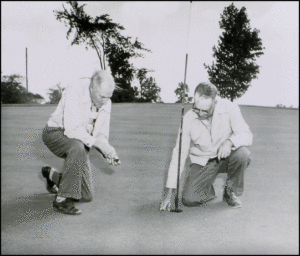 When Rev. Reuel got up to hit, he surveyed the area down #1 fairway where he was going to hit the ball, waggled a little, and then took a mighty swing. He looked down the fairway but could not see the ball; it was still on the tee. There was complete silence. After a few moments he turned to the crowd and said “Folks, that was the most profane silence you have ever heard.”
When Rev. Reuel got up to hit, he surveyed the area down #1 fairway where he was going to hit the ball, waggled a little, and then took a mighty swing. He looked down the fairway but could not see the ball; it was still on the tee. There was complete silence. After a few moments he turned to the crowd and said “Folks, that was the most profane silence you have ever heard.”
The club prospered that first summer. Membership had reached 247, about 40 from Menasha, 81 from Oshkosh, and 126 from Neenah. They were looking forward to the construction of the second nine in the spring. They had engaged a golf pro; this was considered necessary, as was the wearing of knickers by all players. His name was Arthur Saunders, who had come from England a couple of years previously, and spoke with an accent. He had been employed in the sporting goods department of Marshall, Field & Co. in Chicago. He was also the winter pro at the Edgewater Gulf Hotel in Biloxi, Mississippi.
In the spring of 1929 Saunders offered to supervise the construction as well as layout of the second nine, and in that way save the architects fee. This was done. Some additional machinery was purchased in Oshkosh during the construction period, on a time basis under a chattel mortgage. The course was laid out, the land prepared and the tees and greens were built under Mark Prindle’s supervision jointly with Saunders and Gavin Young Sr.
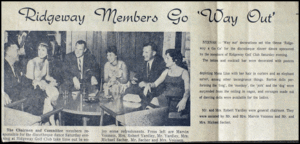 The barn on the premises had been razed the previous summer, but the foundation walls and upper floor of the barn left standing. Men’s and ladies rest rooms had been provided in the South 1/3 of this foundation area, and the other 2/3 was used for machinery storage. The roof of this foundation had been covered by 1 to 1 ½ feet of dirt. This resulted in dampness and mold forming in the rest room area, and they were used only when necessary. A shed that had been on the premises was painted white; a counter built inside, and was used for the pro shop.
The barn on the premises had been razed the previous summer, but the foundation walls and upper floor of the barn left standing. Men’s and ladies rest rooms had been provided in the South 1/3 of this foundation area, and the other 2/3 was used for machinery storage. The roof of this foundation had been covered by 1 to 1 ½ feet of dirt. This resulted in dampness and mold forming in the rest room area, and they were used only when necessary. A shed that had been on the premises was painted white; a counter built inside, and was used for the pro shop.
Members contributed in various ways. Al Angermeyer donated a pick up truck; Bill Sawyer a console radio, Wally Bergstrom bought the furniture for the ladies room, etc.
Things were going along pretty well up to this time. However, in October 1929, the crash of the stock market occurred, marking the beginning of the great depression.
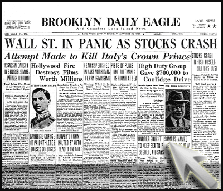 In the next couple of years the membership declined rapidly. The building of the second nine had exhausted the cash, and prospects for the future looked dim. Payments on the new machinery had not been met. Consequently, one day the sheriff notified the club that the machinery would be repossessed if the balance of $2,500 of the chattel mortgage was not paid in full within 3 days.
In the next couple of years the membership declined rapidly. The building of the second nine had exhausted the cash, and prospects for the future looked dim. Payments on the new machinery had not been met. Consequently, one day the sheriff notified the club that the machinery would be repossessed if the balance of $2,500 of the chattel mortgage was not paid in full within 3 days.
This was a critical situation for the survival of Ridgeway Country Club. An angel by the name of Wally Bergstrom appeared. He contacted 4 other angels; John Bergstrom, F.J. Sensenbrenner, C.B. Clark, and S.F. Shattuck, all members of the club, who each bought $500 worth of hurriedly issued preferred stock and the machinery was saved. The retirement of the preferred stock was overlooked in the reorganization that followed in the next few years.
In 1931 or 1932 it became necessary to provide better men’s and ladies facilities. A small clubhouse was erected, which was located about where the present entrance to the club is located. The barn foundation was taken down and the stone used for the foundation of the new building, placed on a concrete slab. The center of the building was a lounge, with a fireplace at the south end. The west wing provided space for the ladies room, and pro shop with an open counter facing the lounge. The east wing contained a small men’s locker room, with 2 shower stalls.
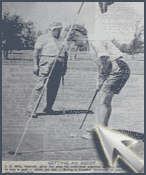 Additions were made to this clubhouse from time to time over the next 15 years, to provide locker room for the ladies, dining and bar space, and to enlarge the men’s quarters. Most of these additions were made during the years of Clark Wiese’s presidency, in the early forties.
Additions were made to this clubhouse from time to time over the next 15 years, to provide locker room for the ladies, dining and bar space, and to enlarge the men’s quarters. Most of these additions were made during the years of Clark Wiese’s presidency, in the early forties.
By 1934 our membership had dwindled to only 78. Not enough cash was coming in from dues and greens ($1 for 18 holes) to meet expenses, pay taxes and interest, etc. A general meeting of the membership was called and held in the basement of the club to determine what course should be followed. (1) Turn the property back to Mark Prindle, or (2) try to operate with only 78 members.
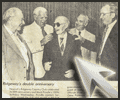 After some discussion a plan was developed whereby the Clayton Land Company was formed to act as a holding company, each share of Neenah-Menasha Golf stock to be exchanged for one share of Clayton Land Co. upon payment of $25 cash. The holding company would then lease the property to the operating golf club for an annual amount equal to their fixed expenses. The new golf club was organized and the above plan put into operation. At a meeting in the 3rd floor auditorium of the old City Hall in Neenah, the matter of a name for the new club was discussed. Many names were suggested, and finally Mark Prindle stood up and said “Our road out there has been known for years as Ridge Road; why not call it Ridgeway Golf Club.” So, Mr. Prindle named the club. Incidentally, at the time of the reorganization, Mark voluntarily endorsed a payment of $1,000 on the mortgage note, for which he received nothing.
After some discussion a plan was developed whereby the Clayton Land Company was formed to act as a holding company, each share of Neenah-Menasha Golf stock to be exchanged for one share of Clayton Land Co. upon payment of $25 cash. The holding company would then lease the property to the operating golf club for an annual amount equal to their fixed expenses. The new golf club was organized and the above plan put into operation. At a meeting in the 3rd floor auditorium of the old City Hall in Neenah, the matter of a name for the new club was discussed. Many names were suggested, and finally Mark Prindle stood up and said “Our road out there has been known for years as Ridge Road; why not call it Ridgeway Golf Club.” So, Mr. Prindle named the club. Incidentally, at the time of the reorganization, Mark voluntarily endorsed a payment of $1,000 on the mortgage note, for which he received nothing.
Over the course of time, the club recovered financially and by 1949 was completely free from debt.
Written by:
Elmer J. Schultheis
September 4th, 1978